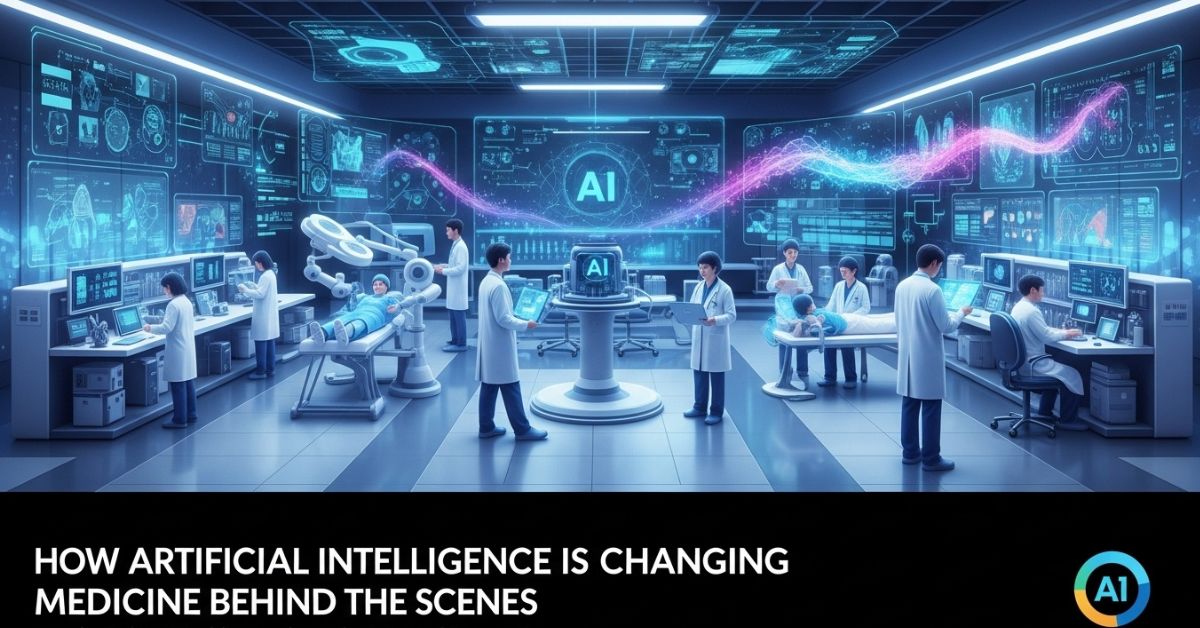Artificial intelligence (AI) is no longer a futuristic concept—it’s an active force revolutionizing modern healthcare. While some changes are visible in robotic surgeries or AI-assisted diagnostics, many of the most transformative developments are happening quietly behind the scenes. From early disease detection to streamlined administrative processes, AI is redefining how medicine is practiced, delivered, and evolved.
In this comprehensive guide, we explore how artificial intelligence is changing medicine behind the scenes and what that means for healthcare professionals, patients, and the future of medical innovation.
Contents
- 1 The Silent Revolution: AI’s Quiet Takeover in Medicine
- 2 AI’s Expanding Role in Clinical Decision Support Systems (CDSS)
- 3 AI in Remote Monitoring and Telehealth
- 4 AI in Epidemiology and Public Health
- 5 The Intersection of AI and Mental Health
- 6 Ethical and Regulatory Considerations
- 7 Real-World Examples of AI in Medicine
- 8 The Future of AI in Medicine
- 9 Conclusion
- 10 FAQs: How Artificial Intelligence Is Changing Medicine Behind the Scenes
- 10.1 How does AI help in early disease detection?
- 10.2 Can AI replace doctors in the future?
- 10.3 Is patient data safe with AI systems?
- 10.4 How is AI used in hospital administration?
- 10.5 What are the risks of AI in medicine?
- 10.6 How is AI improving drug discovery?
- 10.7 Are there any regulations for AI in healthcare?
- 10.8 How does AI contribute to personalized medicine?
The Silent Revolution: AI’s Quiet Takeover in Medicine
Behind every test result, hospital visit, and medical record lies a network of algorithms enhancing outcomes. AI in medicine is working quietly yet powerfully in areas many patients and even some clinicians might not notice.
1. AI-Driven Medical Imaging and Diagnostics
Medical imaging is one of the areas where AI is having the biggest effects. Algorithms now analyze X-rays, MRIs, and CT scans faster and often more accurately than human radiologists.
Behind-the-scenes impact:
- AI detects abnormalities such as tumors or fractures.
- Machine learning helps prioritize urgent cases.
- Radiology reports are generated with greater speed and accuracy.
Hospitals globally are adopting AI tools that read images within seconds, reducing diagnostic errors and allowing clinicians to focus on patient care.
2. Predictive Analytics for Disease Prevention
Predictive modeling uses data from electronic health records (EHRs) to anticipate health issues before they manifest.
Examples include:
- Forecasting hospital readmissions.
- Identifying at-risk patients for diabetes or cardiac conditions.
- Using wearable device data to monitor vital signs.
By catching early warning signs, healthcare providers can intervene sooner, improving outcomes and reducing costs.
3. Enhancing Drug Discovery and Development
Drug discovery is often a decade-long process costing billions. AI accelerates this timeline by modeling how molecules interact and predicting drug efficacy.
AI’s role in pharma includes:
- Identifying promising compounds.
- Repurposing existing drugs.
- Simulating clinical trials digitally.
These innovations reduce the time between research and real-world treatments.
4. Personalized Treatment Plans
How artificial intelligence is changing medicine behind the scenes can also be seen in treatment customization. AI analyzes genetic data, lifestyle factors, and response patterns to tailor therapies for individual patients.
Key areas impacted:
- Oncology (personalized cancer therapies).
- Psychiatry (mental health medication matching).
- Chronic illness management (diabetes, hypertension).
Patients receive treatments most likely to work for their unique profiles, leading to better adherence and faster recovery.
5. Streamlining Administrative Workflows
Doctors often spend hours documenting patient interactions and handling insurance claims. AI automates these tasks, freeing up time for patient care.
Behind-the-scenes applications:
- AI-driven chatbots handle appointment scheduling.
- Natural language processing (NLP) transcribes clinical notes.
- Claim processing and billing automation improves accuracy.
Clinicians report reduced burnout, and hospitals enjoy improved operational efficiency.
AI’s Expanding Role in Clinical Decision Support Systems (CDSS)
Clinical decision support systems use AI to aid healthcare professionals in making accurate, timely decisions based on data and evidence.
Key functionalities:
- Recommending treatment protocols.
- Alerting potential adverse drug interactions.
- Highlighting clinical guidelines during diagnosis.
By integrating seamlessly into EHRs, these systems are becoming trusted aides to clinicians.
AI in Triage and Patient Flow Management
AI assists hospitals in managing patient traffic by predicting case severity and triaging effectively.
How it works:
- AI models assess vital signs and symptom data.
- Patients are routed to appropriate departments.
- Emergency departments are relieved from overflow.
The result is reduced wait times and better patient satisfaction.
AI in Remote Monitoring and Telehealth
Telemedicine surged in popularity during the COVID-19 pandemic. AI has since become integral in monitoring patients outside traditional clinical settings.
Smart Wearables and AI Integration
Wearables now come equipped with AI-powered analytics that provide real-time health data.
Examples:
- Heart rate monitoring.
- Sleep analysis.
- Blood glucose and oxygen tracking.
AI interprets these metrics and alerts both patients and clinicians of anomalies.
Virtual Health Assistants
AI chatbots and virtual nurses offer around-the-clock health support.
Common functions include:
- Medication reminders.
- Symptom assessment.
- Answering FAQs on health conditions.
These tools help reduce unnecessary clinic visits while maintaining patient engagement.
AI in Epidemiology and Public Health
AI’s influence extends beyond individual care into population-level health management.
Tracking Disease Outbreaks
AI systems can analyze social media, search trends, and health records to predict and track disease outbreaks in real time.
Example: During the COVID-19 pandemic, AI helped predict virus spread patterns and identify hot zones faster than traditional surveillance methods.
Managing Healthcare Resources
Hospitals and public health agencies use AI to allocate resources more effectively:
- Predicting ICU bed demand.
- Managing vaccine distribution.
- Optimizing staffing during flu seasons.
These behind-the-scenes applications improve care delivery while reducing strain on healthcare systems.
The Intersection of AI and Mental Health
AI is making substantial progress in the realm of mental health—a domain often underfunded and overlooked.
Emotion Recognition Algorithms
AI tools analyze facial expressions, voice tone, and text patterns to detect emotional states.
Applications:
- Identifying depression or anxiety early.
- Providing feedback to therapists.
- Customizing mental health interventions.
Chatbots for Cognitive Behavioral Therapy (CBT)
AI-driven CBT chatbots are being deployed to offer therapy-like experiences to patients who might not have access to traditional therapy.
Notable platforms: Woebot, Wysa
While not replacements for human therapists, they offer timely support and emotional guidance.
Ethical and Regulatory Considerations
With great power comes great responsibility. As AI integrates deeper into medicine, ethical and legal challenges emerge.
Patient Data Privacy
AI thrives on data. Ensuring that personal health information remains confidential is paramount.
Concerns include:
- Data breaches.
- Consent for data use.
- Ownership of health insights generated by AI.
Regulations like HIPAA in the U.S. and GDPR in Europe aim to protect patients, but continuous monitoring is needed.
Bias in AI Algorithms
AI systems can inherit biases from training data, leading to disparities in care.
For example:
- Undiagnosed conditions in minority groups.
- Uneven distribution of care recommendations.
Developers and healthcare institutions must audit and update AI systems regularly to ensure fairness and equity.
Regulatory Oversight
Governments and regulatory bodies are crafting frameworks for AI in medicine:
- FDA approval for AI diagnostic tools.
- EU guidelines on medical AI safety.
- Standards for explainability and transparency.
Robust governance ensures that how artificial intelligence is changing medicine behind the scenes remains ethical and safe.
Real-World Examples of AI in Medicine
Understanding how artificial intelligence is changing medicine behind the scenes becomes clearer with tangible examples.
IBM Watson in Oncology
Watson helps oncologists review vast medical literature to recommend cancer treatments. It personalizes care by considering individual patient factors.
DeepMind and Eye Disease
DeepMind’s AI accurately detects over 50 eye diseases from retina scans, supporting early interventions and reducing blindness risk.
Aidoc and Radiology Support
Aidoc’s AI algorithms assist radiologists by flagging urgent cases such as brain bleeds or pulmonary embolisms, improving emergency room workflows.
Tempus in Precision Medicine
Tempus leverages AI to analyze clinical and molecular data to personalize cancer treatment. It integrates EHRs, lab results, and genomic testing seamlessly.
These platforms illustrate the breadth and depth of AI’s influence across specialties.
The Future of AI in Medicine
The journey is just beginning. As technology advances, the scope of AI will only grow.
Next-Gen Capabilities to Watch:
- AI-powered surgical robots: Greater precision and minimally invasive procedures.
- Digital twins: Simulated models of patients for testing treatments.
- AI in genomics: Advanced gene editing insights and rare disease diagnosis.
- Autonomous diagnostic agents: Self-updating AI capable of evolving with new research.
Collaboration between technologists and healthcare experts will be vital to unlocking AI’s full potential.
Education and AI Literacy for Healthcare Professionals
For AI to truly integrate into healthcare, doctors, nurses, and administrators must understand it.
What’s needed:
- AI literacy in medical training.
- Ongoing professional development.
- Cross-disciplinary teamwork between IT and clinical teams.
Equipping medical professionals with AI knowledge ensures safer and more effective integration.
Conclusion
How artificial intelligence is changing medicine behind the scenes is both complex and awe-inspiring. From streamlining hospital operations to detecting diseases years before symptoms arise, AI is quietly transforming every layer of healthcare. As the technology continues to evolve, the balance between innovation, privacy, and ethics will shape its legacy.
Healthcare professionals and patients alike must remain informed and involved as AI becomes an invisible but indispensable part of modern medicine.
FAQs: How Artificial Intelligence Is Changing Medicine Behind the Scenes
How does AI help in early disease detection?
AI analyzes large datasets to identify subtle patterns and biomarkers, allowing for earlier and more accurate disease detection than traditional methods.
Can AI replace doctors in the future?
No, AI is designed to augment—not replace—healthcare providers. It handles data-heavy tasks, enabling doctors to focus on patient interaction and decision-making.
Is patient data safe with AI systems?
Leading healthcare systems implement strict security protocols and comply with regulations like HIPAA and GDPR to protect patient data. However, continuous vigilance is essential.
How is AI used in hospital administration?
AI automates administrative tasks such as billing, scheduling, and clinical documentation, increasing efficiency and reducing errors.
What are the risks of AI in medicine?
Risks include algorithmic prejudice, over-reliance on automation, and data privacy issues. These challenges require robust oversight and human supervision.
How is AI improving drug discovery?
AI models predict molecular interactions, simulate clinical trials, and identify drug repurposing opportunities, significantly shortening the drug development timeline.
Are there any regulations for AI in healthcare?
Yes, many countries have regulatory frameworks in place, including the FDA in the U.S. and the EMA in Europe, ensuring safety, transparency, and accountability in AI applications.
How does AI contribute to personalized medicine?
By analyzing genomic, clinical, and lifestyle data, AI tailors treatments to individual patients, improving outcomes and minimizing adverse effects.
By understanding how artificial intelligence is changing medicine behind the scenes, stakeholders can better navigate this digital transformation and ensure that technology enhances—not compromises—human care.

Harper Leigh is a dedicated writer at hsnime.co.uk, where she crafts engaging and insightful content on a wide range of topics. With a passion for storytelling and connecting with readers, Harper aims to inspire, inform, and entertain through her articles.






